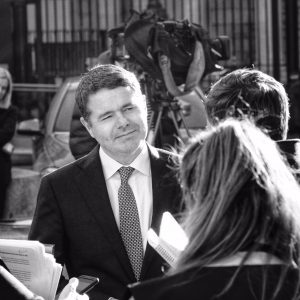Findings reveal degree of spare capacity in the economy today with possible overheating pressures in the years ahead
The Minister for Finance and Public Expenditure and Reform, Paschal Donohoe TD, has today (Sunday) welcomed the publication by his Department of two technical research papers on measuring the productive potential of the Irish economy.
Understanding how close the economy is to its potential output level, which is also referred to as the output gap, is an important input into the fiscal policymaking process and management of the economy. It enables the Department to better evaluate the appropriate fiscal stance and the sustainability of public finances over the medium term.
To date, the Department has used a harmonised approach (i.e. common to all EU Member States), which has at times resulted in counterintuitive estimates (for example previous estimates have suggested the presence of capacity constraints in the economy during periods of high unemployment).
The new methodologies, the results of which were published in Budget 2019, provide a much more plausible estimate of the economy’s position in the economic cycle.
The key insights from the Department’s new approach are:
- The economy would appear to be operating marginally below its potential level in 2018; in other words there is a degree of additional capacity in the economy. This is consistent with limited inflationary pressures in the economy, modest credit growth and a labour market not yet at full employment.
- It is likely that the economy will reach and exceed its sustainable level of production in the coming years. This is consistent with the Department’s view that the economy will soon reach full employment.
Speaking following the publication of the reports, Minister Donohoe said: ‘I welcome the publication of these research papers today and commend my Department officials for their excellent work carried out in respect of this important issue’.
“Potential output and the output gap are important inputs to fiscal policy making. They enable the Department to better evaluate the appropriate fiscal stance and the sustainability of public finances over the medium term. They are also relevant for assessment of compliance with the fiscal rules under the preventive arm of the Stability and Growth Pact. In this respect, it is important to note that compliance with the SGP will still be based on the EU harmonised approach.”
“I note that the analysis indicates that the output gap is expected to be marginally negative in 2018, which is consistent with limited inflationary pressures in the economy and remaining slack in the labour market at this time. The estimated output gap is forecast to turn slightly positive in 2019 and increases thereafter, pointing to signs of overheating over the medium term, which is something the Government is acutely aware of and remains cognisant of at all times.
“This is why we must focus on maintaining competitiveness-oriented policies, whilst avoiding pro-cyclical policy measures. To this end, the Government is actively building capacity within the economy through increased public capital investment. This targeted investment is designed to address the bottlenecks to growth which emerged during the economic recovery, such as the need for residential development and public infrastructure investment.”
The Government will also continue to implement budgetary policies designed to ensure economic stability and fiscal sustainability. The Government is eliminating the deficit this year – earlier than expected – and are currently establishing the Rainy Day fund. This prudent approach to our public finances will help to mitigate against any future downturn in economy activity.
“We have made exceptional progress in recent years in stabilising our economy, getting people back to work and keeping the train on the tracks. These statistical estimates represent an important additional input to the Department’s overall approach to assessing the economy’s stance and again I thank my officials for their efforts which continue to inform decision making that is in the best interest of the Irish people.”
ENDS
Note to editors
Potential output is often defined as the level of output that an economy can sustainably produce without causing inflation to increase or decrease.
The output gap is the difference between actual output (i.e. GDP) and its potential level.
When the economy produces above its potential level of output, the output gap is positive suggesting that the economy is producing above its sustainable level. When the economy produces below its potential level of output the output gap is negative suggesting that the economy’s resources are being underutilised. Potential output and the output gap cannot be measured directly and must be estimated.
Detailed summary
The Department’s New Publications
The first paper, Measuring an Economy’s Cyclical Position, written by Gavin Murphy, Martina Nacheva and Luke Daly examines the broad range of methodologies for estimating potential output, and evaluates their respective strengths and weaknesses in order to determine the preferred methodological approach in the development of the Department’s new models.
The paper also contains a review of the main approaches applied by Irish and international institutions in recent years. It finds that there is a diversity of modelling approaches used across institutions with each tending to use more than one approach. Institutional preferences, legal requirements and model complexity appear to be important factors affecting model selection.
The second paper, Estimating Ireland’s Output Gap, also written by Gavin Murphy, Martina Nacheva and Luke Daly, describes the methodology the Department uses to produce alternative estimates of the output gap. Consideration is also given to the selection of economic output measures that accurately reflect economic activity in Ireland.
